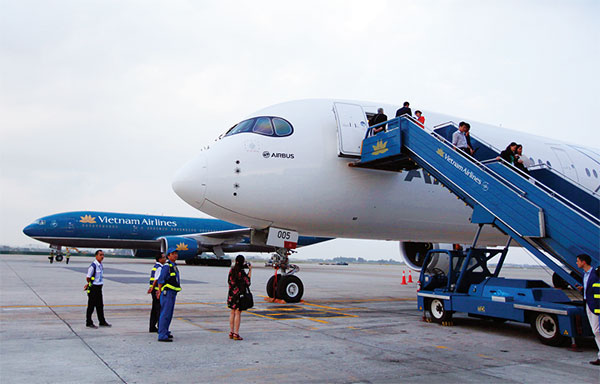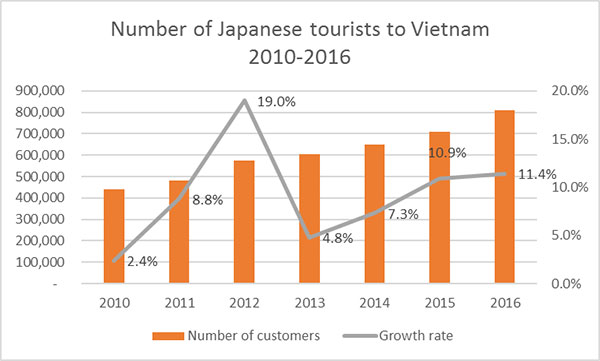High-level appointment to draw Japanese ties tighter
 |
This assignment is said to be a bid to step up cooperation as well as promote the two countries as holiday and business destinations.
Mutually beneficial cooperation
All Nippon Airways (ANA) recently nominated Koji Shibata, its senior vice president and Asia-Pacific director of strategic planning, for a position on the board of directors in Vietnam Airlines Corporation.
Shibata is the representative of ANA’s capital in Vietnam Airlines. He is also responsible for the rights and obligations that come with ANA’s 107.7 million shares, which is equivalent to 8.771 per cent of Vietnam Airlines’ chartered capital.
Previously, in July 1, 2016, ANA transferred $109 million to Vietnam Airline to finalise its biggest foreign investment deal to date and officially became a strategic shareholder of the Vietnamese national airlines.
“I am honoured to be appointed to the board of directors in Vietnam Airlines. I voluntarily devote myself to the development of the corporation. Both parties will cooperate for the growth of this airline market and develop on the basis of mutual benefits. This cooperation will also promote travelling among the two countries, encourage cultural and economic exchange, and enhance bilateral understanding between Vietnam and Japan,” Shibata said after his election as a member of the board of directors in Vietnam Airlines’ extraordinary shareholders’ meeting in February 20, 2017.
According to Pham Ngoc Minh, chairman of the board of directors, ANA has the capacity to support and accompany the corporation in the process of developing, expanding its market, and upgrading the quality of services and corporate governance.
Currently, Vietnam Airlines operates regular flights to 20 domestic and 29 international destinations. It also focuses on connecting flights through the gateway airports in Hanoi and Ho Chi Minh City, and approaches plenty of customers in the region to directly compete with the huge transit hubs like Hong Kong, Bangkok, Singapore, Kuala Lumpur or the Greater Mekong Subregion. Besides, Vietnam Airlines operates 66 weekly flights to Japan, an entirely novel addition to ANA’s line-up.
In addition to passenger transport, Japanese investors also pay attention to air traffic management. Vo Huy Cuong, deputy director of Civil Aviation Authority of Vietnam (CAAV), revealed that Japan proposed the establishment of a special purpose corporation (SPC) with the aim of obtaining, analysing, and supplying information about air traffic management for the related companies. SPC will be a joint venture with 51 per cent Vietnamese and 49 per cent Japanese capital. Vietnamese authorities are still considering this model.
Vo Huy Cuong added that investment opportunities in the $3.53-billion Long Thanh International Airport phase one are still available for international investors, including Japanese enterprises that had been pursuing this project from the very first days.
An exciting market
 |
According to CAAV, based on current agreements, both countries’ airline corporations have unlimited rights to fly on the air routes between Vietnamese and Japanese destinations (except for Haneda Airport in Tokyo). At present, ANA, Japan Airlines, and Vanilla Air operate five air routes from Tokyo (Narita and Haneda) to two destinations in Vietnam (Hanoi and Ho Chi Minh City) with the frequency of 42 weekly flights every afternoon.
Meanwhile, Vietnam Airlines is the sole airline in Vietnam to operate flights to Japan at very high frequency. By the end of January 2017, Vietnam Airlines exploited ten air routes from three domestic airports (Ho Chi Minh City, Hanoi, and Danang) to four Japanese destinations in Tokyo (Haneda and Narita) and Nagoya (Fukuoka and Osaka), with the frequency of 66 weekly flights every afternoon.
In 2016, nearly two million passengers whizzed through the air routes between the two countries, an increase of 18.6 per cent compared to 2015, and the planes in both directions were 80 per cent filled on average. In particular, Vietnam Airlines transported 1.28 million customers, which accounted for 66 per cent of the market, with the average seat occupancy over 82.2 per cent.
Vo Huy Cuong said that in 2017, Vietjet Air and Jetstar Pacific were allowed to operate flights from Hanoi or Danang to Osaka.
Currently, the biggest obstacle to airlines in Vietnam is the number of flights to Haneda per day. The flights to Haneda, a favourable transit hub in Japan, are limited to two flights per day only (one in daytime and one at night time).
What the stars mean:
★ Poor ★ ★ Promising ★★★ Good ★★★★ Very good ★★★★★ Exceptional
Latest News
More News
- The destinations powering Vietnam’s festive season travel demand (December 04, 2025 | 18:33)
- Vietnam named among the world’s most exciting winter destinations (December 04, 2025 | 15:10)
- Phu Tho emerges as northern Vietnam’s new tourism hub (December 01, 2025 | 17:00)
- Vietjet completes Airbus A320/A321 updates ahead of deadline (December 01, 2025 | 09:49)
- Vietjet resumes Con Dao flights from early December (November 28, 2025 | 15:24)
- Free tickets, Lunar New Year promotions on offer at Vietjet Mega Livestream (November 26, 2025 | 15:32)
- Scandinavian Airlines and Vietnam Airlines broaden agreement with new routes (November 25, 2025 | 17:04)
- Halong Cruise Port welcomes over 3,100 international visitors (November 12, 2025 | 18:06)
- Vietnam.travel climbs to second place in Southeast Asia website rankings (November 12, 2025 | 18:01)
- Cat Ba named among Southeast Asia’s top island adventures (November 11, 2025 | 18:09)


















 Mobile Version
Mobile Version